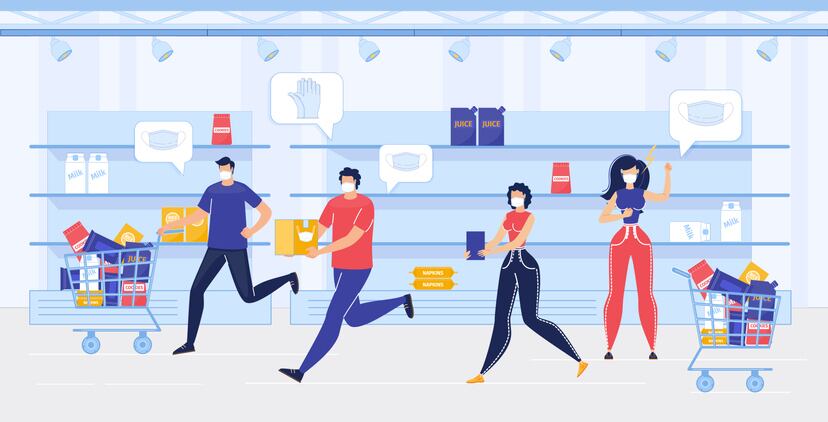Since the pandemic was declared, consumer visits to dollar stores on the weekends are up more than 20% year over year and up between 5% and 15% on weekdays, according to smartphone location data from Sense360 shared by Dairy Farmers of Wisconsin VP of Insights and Strategy Jen Walsh.
“Not only are dollar stores growing their share of foot traffic … but they are also growing in terms of dollars spent per visit,” Walsh said, noting that the number of transactions at dollar stores are up 25% post-COVID-19 for the weeks of March 9-29 compared to pre-COVID-19 for the weeks of Jan. 13 through March 8.
“That is a lot of growth for that channel, both in terms of traffic and spend per visit,” she said.
She attributes the shift to dollar stores as a safety measure taken by consumers who want to limit their exposure to COVID-19 by limiting their contact with others and time in confined spaces with others.
“There is a factor of dollars stores being easy to get into and easy to get out of when you are trying to limit your exposure to other people. … If you go to a dollar store, you are not waiting in line to get in like you might have been if you are going to a club store. You are not shoulder to shoulder with other shoppers once you are inside. You can get in and you can get out, which is really important to shoppers right now,” she explained.
Dollar stores also likely are attractive because of the price sensitive value the offer consumers, many of whom have lost jobs or had their hours reduced since the coronavirus began spreading in the US.
Citing the “staggering” number of initial claims filed for unemployment in the past month, Walsh added that the value component of dollar stores likely will become increasingly important as the economy continues to take a hit from measures designed to slow the spread of coronavirus.
In addition to dollar stores, consumers are visiting supermarkets more often with trips up as high as 15% on any given day year-over-year, but more often hovering between 5% and 10% higher year-over-year on any given day in the weeks since the pandemic was declared, Walsh said.
While trips to supermarkets are up, Walsh notes that transactions remain steady – up only 2% in the weeks following the start of the pandemic compared to 1% for the first part of the year compared to the same time periods last year. The discrepancy between the increase in visits and the relatively flat transactions suggests that people might be shopping together with only one person conducting a transaction.
While transactions are steady at supermarkets the amount spent is up 34% since the pandemic began compared to 0% for the first part of the year compared to the same time in 2019, Walsh noted.
Club, mass and c-store visits are slowing
While these two channels are growing, others are slowing, she added.
After an initial surge of almost 40% in visits to club stores on March 11, consumer interest dropped sharply with the rate of visits consistently falling under those of dollar and supermarket since the pandemic began.
Notably, visits to club stores declines sharply on weekend days, dropping between 15% and 25% lower than the same day the previous year, according to the data Walsh shared. However, during the first few weeks of the pandemic, visits to club stores were up on weekdays between 5% and 10%, but since the start of April they have been flat or below the number of visits on the same days last year.
“As people’s schedules shift with working from home, and many people having reduced work hours, they are also shifting when they shop these club stores – again likely trying to minimize their exposure by hitting the stores when they think fewer people will be there,” Walsh said. “Other research I have seen indicates that two-thirds of shoppers are trying to shop in slower times as a precaution and that is evidenced here.”
Visits to convenience stores also have dropped since the pandemic began, with visits flat or down 15% since April 6, according to the Sense360 data. Transactions have fallen 23% since the pandemic began and the amount per transaction is down 10%, Walsh noted.
“When you think about how we are living our lives right now, this kind of makes sense,” said Walsh. She explained: “Most convenience stores are affiliated with gas stations, and I don’t know about you, but I am not driving anywhere. I have no need to go to a gas station as we are all staying at home.”
E-commerce continues to climb
Many consumers are shifting to ecommerce for a completely contactless or much more limited contact shopping experience, according to Walsh, who noted that online food sales were up 183% in March 2020 compared to March 2019.
“A third of US households have now used an online grocery service compared to just 13% in August, which was just about 8 months ago. So, really incredible growth in the online landscape,” she said, adding that “yet more growth is expected as more than a third of shoppers expect to purchase groceries online even more in the future.”
Walsh noted that the big question on many retailers’ and brands’ minds is whether shoppers will return to brick and mortar stores once the pandemic ends or if they will continue to shop online “now that they have gotten over that initial hurdle of trying it for the first time.”
The answer remains to be seen, she said, but she added, “I have seen some data from the NPD Group that shows once consumers try it once…they kind of get hooked and they never really go back to their old ways of shopping – at least not entirely.”




